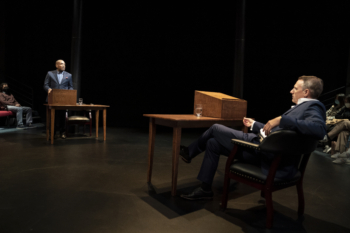Photo credit: Grieg Sargeant and Ben Jalosa Williams in Baldwin and Buckley at Cambridge. (Photo by Joan Marcus)
Baldwin and Buckley at Cambridge • Press
- The New Yorker October 7, 2022
‘Baldwin and Buckley at Cambridge’ review — a mesmerizing historical recreation
by Diep Tran
Why watch theatre instead of a YouTube video? That’s a question that might pop into your head upon seeing the synopsis for Baldwin and Buckley at Cambridge, the new play from Elevator Repair Service currently running at The Public Theater. It is a beat-by-beat recreation of a real-life televised debate between the writer James Baldwin and the conservative William F. Buckley in 1965, around the question, “Has the American Dream been achieved at the expense of the American Negro?” That debate is also available to view in full on YouTube. But this theatrical version makes a compelling case not just for the veracity of Baldwin’s arguments, but also for the importance of live theatre.
ERS specializes in dramatizing found texts such as novels and court transcripts (its verbatim reading of The Great Gatsby, called Gatz, was eight hours long). Baldwin and Buckley at Cambridge is less overwhelming than ERS’s previous work; at just one hour, it lasts as long as the original Baldwin and Buckley debate. And it’s more straightforward than ERS’s previous shows. There are no visual flairs here to enhance the text and theatricalize it, no sheets of paper flung into the air (like in Gatz). Instead, the focus in Baldwin and Buckley at Cambridge is solely on the two men and their arguments.
Greig Sargeant, who conceived the play with ERS artistic director John Collins, plays Baldwin, and Ben Jalosa Williams plays Buckley. Both actors are powerful orators, personable and charismatic — it’s easy to hang onto their every word. And they’re not directly mimicking their subjects. Sargeant has a more calm delivery than Baldwin does in the debate, not gesticulating as much — though his voice grows steadily more passionate as he progresses. Williams has less of a Southern drawl than the real-life Buckley, instead opting for a faux gentile delivery more reminiscent of modern conservative politicians.
Sure, it might be easier to watch this debate online, but with modern distractions (such as an iPhone), it’s much easier to mentally remove yourself from what you are seeing and listening to. At the Public, where the audience is seated at three sides of the stage and the house lights are on, onlookers are forced to pay attention and to hang on every word. It’s a testament to the unfortunate timelessness of Baldwin’s words that when he says of poor white people, “They have one enormous knowledge and consolation which is like a heavenly revelation: at least they are not Black,” the audience murmurs and chuckles in agreement.
What this recreation also allows the audience to do, that they can’t do at home, is observe these men when they’re not at the podium, to see how they watch their opponent. Here the difference in body language is stark: Sargeant’s Baldwin leans forward, his fingertips pressed together and his eyebrows furrowed in a decidedly “Is this guy for real?” manner. In contrast, Williams’s Buckley leans back on his chair, his legs spread, one arm relaxedly draped over the back of the chair, as if the event is a game. In these unspoken moments, the play goes beyond mimicry and becomes a character study: Who has true stakes in this? Whom does racism truly oppress, and for whom is racism just a concept?
The costumes by Jessica Jahn denote this play isn’t just a period piece. Both Sargeant and Williams are dressed in modern, close-fitted suits and dress shirts with no ties. As for their colleagues in the opening arguments, Mr. Heycock (a moving Gavin Price) wears khakis, and Mr. Burford (a slithering Christopher-Rashee Stevenson) wears slacks, short-sleeves, and a yellow sweater tied around his shoulders.
The subtext is clear: the words Baldwin and Buckley are speaking are from over 50 years ago, but they might as well be spoken today. Today, African Americans are still fighting against voter suppression. White Americans’ response remains, “At least the racism isn’t as bad as it used to be.” Yet the true power of the play lies in its last 10 minutes, a fictional conversation gathered from letters and interviews between Baldwin and Lorraine Hansberry. The scene is woefully short, and should be longer, but it is the theatrical equivalent of a cold splash of water to the face.
When Hansberry says, “We have to find some way with these dialogues to show and to encourage the white liberal to stop being a liberal and become an American radical,” she and Baldwin look directly at the audience. There, the true genius of Baldwin and Buckley at Cambridge is revealed. Listening to this dialogue may feel educational, even like medicine, but they are no substitute for radical action.
